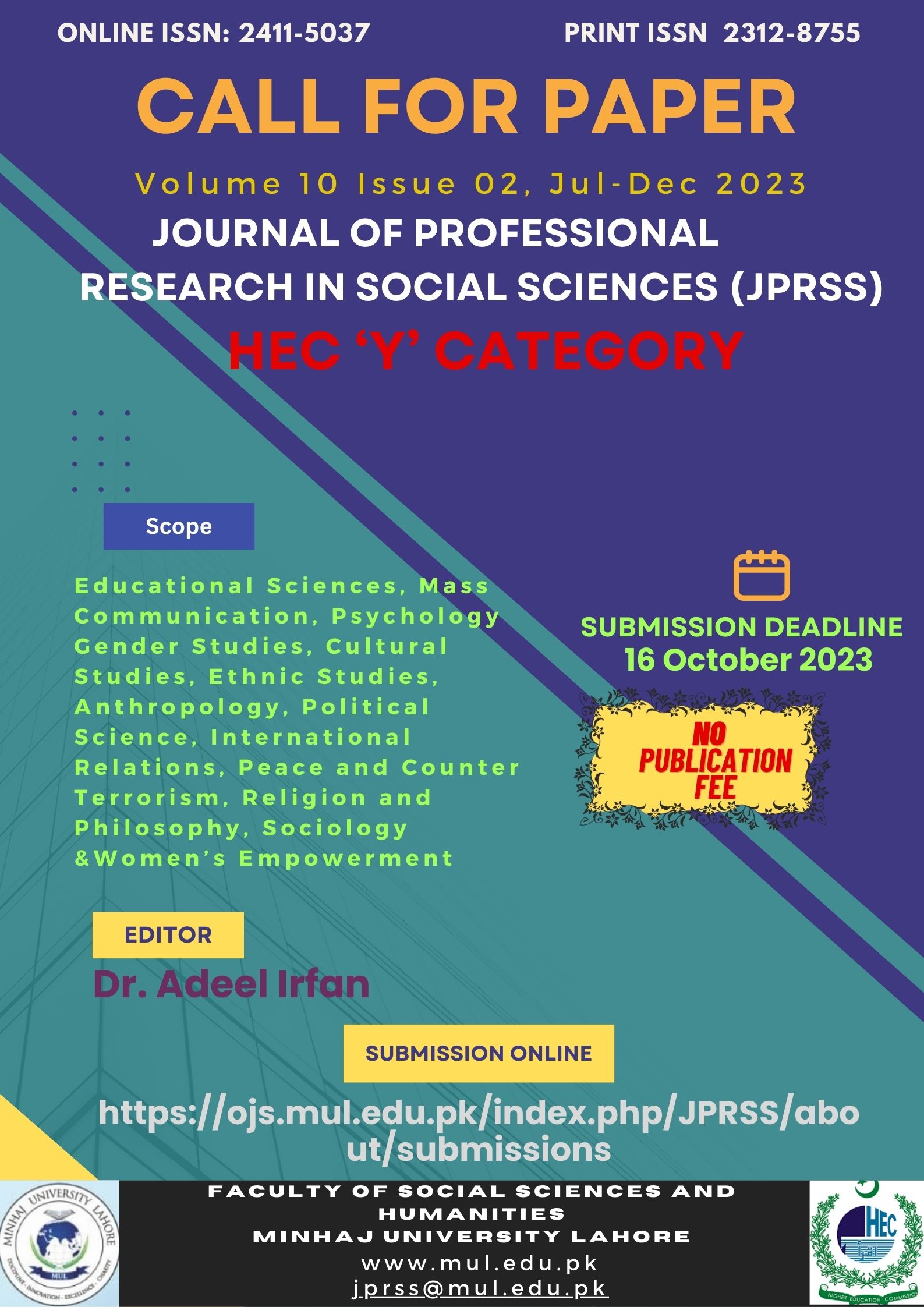The Challenges Faced by Women in Blue-Collar Jobs
DOI:
https://doi.org/10.58932/MULA0021Keywords:
Blue color jobs, women, double burden, challenges, PakistanAbstract
Since the beginning of the Industrial Revolution, there has been a noticeable increase in the number of women in the labor force where they are consistently making significant economic contributions. Despite constituting 39.3% of the labor force in Pakistan, women face numerous challenges in their workplaces due to societal norms, and behaviors. This study explores the challenges faced by women holding blue-collar jobs in educational institutions in Lahore, Pakistan. This qualitative research unveils a nuanced array of obstacles confronted by women employed in blue-collar positions. In-depth interviews were conducted with 15 female security guards and janitors, purposefully selected from two private higher educational institutions in Lahore. Thematic analysis was conducted and a total of four themes were extracted from the data. The findings expose a complex web of challenges that women in blue-collar jobs face including gender-based discrimination, the double burden of domestic and job responsibilities, unique restraints of blue-collar jobs and institutional facilities available to formal labor, and finally the significance of family support. Blue-collar jobs have been an arena of a male-dominated workforce. Women’s participation in this sector has been understudied in Pakistan. The present study aims to highlight the unique challenges that are linked to blue-collar jobs and women’s experiences of these issues.
References
Abbas, S. M. N., Athar, S. A., & Herani, G. (2010). Gender based wage discrimination and its impact on performance of blue collar workers: Evidence from Pakistan. KASBIT Business Journal, 3(1), 45-63.
Ahmad, A., Malik, M. I., & Ali, M. (2011). Examining a chain relationship of social support, job satisfaction and work family balance: A case of working women in Pakistan. African Journal of Business Management, 5(34), 13154-13158.
Andersen, L. L., Fallentin, N., Thorsen, S. V., & Holtermann, A. (2016). Physical workload and risk of long-term sickness absence in the general working population and among blue-collar workers: prospective cohort study with register follow-up. Occupational and Environmental Medicine, 73(4), 246-253.
Baker, M. (2010, May). Motherhood, employment and the “child penalty”. In Women's Studies International Forum (Vol. 33, No. 3, pp. 215-224). Pergamon.
Berdahl, J. L., Cooper, M., Glick, P., Livingston, R. W., & Williams, J. C. (2018). Work as a masculinity contest. Journal of Social Issues, 74(3), 422-448.
Bergmann, B. R. (2011). Sex segregation in the blue-collar occupations: Women’s choices or unremedied discrimination? Comment on England. Gender & Society, 25(1), 88-93.
Caraway, T. L. (2007). Assembling women: The feminization of global manufacturing. Cornell University Press.
Cha, Y. (2013). Overwork and the persistence of gender segregation in occupations. Gender & society, 27(2), 158-184.
Chen, N., Conconi, P., & Perroni, C. (2007). Women's earning power and the ‘double burden ‘of market and household work.
Clougherty, J. E., Eisen, E. A., Slade, M. D., Kawachi, I., & Cullen, M. R. (2011). Gender and sex differences in job status and hypertension. Occupational and environmental medicine, 68(1), 16-23.
Costa, D. L. (2000). From mill town to board room: The rise of women's paid labor. Journal of Economic Perspectives, 14(4), 101-122.
Cowan, R. L., & Bochantin, J. E. (2011). Blue-collar employees' work/life metaphors: Tough similarities, imbalance, separation, and opposition. Qualitative Research Reports in Communication, 12(1), 19-26.
Elser, H., Falconi, A. M., Bass, M., & Cullen, M. R. (2018). Blue-collar work and women's health: A systematic review of the evidence from 1990 to 2015. SSM-population health, 6, 195-244.
England, P. (2010). The gender revolution: Uneven and stalled. Gender & Society, 24(2), 149-166.
Hegewisch, A., Liepmann, H., Hayes, J., & Hartmann, H. (2010). Separate and not equal? Gender segregation in the labor market and the gender wage gap. IWPR Briefing Paper, 377, 1-16.
Hesmondhalgh, D., & Baker, S. (2015). Sex, gender and work segregation in the cultural industries. The sociological review, 63(1_suppl), 23-36.
Imam, M.A. et al. (2023) ‘Contextualizing research approaches: The role of Western and Islamic philosophies in shaping methodology and knowledge creation’, Al-Irfan, 8(16), pp. 69–90.
Jacobs, A. W., & Padavic, I. (2015). Hours, scheduling and flexibility for women in the US low‐wage labour force. Gender, Work & Organization, 22(1), 67-86.
Khan, A. (2007). Women and paid work in Pakistan. Karachi: Collective of Social Science Research.
McDonald, P. (2012). Workplace sexual harassment 30 years on: A review of the literature. International Journal of Management Reviews, 14(1), 1-17.
Moulabuksh, M., Zarar, R., & Shah, N. A. (2022). Issues of Female Labourers in Pakistan. Pakistan Journal of International Affairs, 5(2).
O'Sullivan, S. (2007). Gender and the Workforce. O'Sullivan, Sara (Ed.). Contemporary Ireland: A Sociological Map.
Pakistan Labour Force Survey 2020-21, Ministry of Planning, Development & Special Initiatives Pakistan Bureau of Statistics. Government of Pakistan.
Peetz, D., & Murray, G. (2016). Fear and Experience of Harassment in Male-Dominated Blue-Collar Work. Available at SSRN 2720001.
Perales, F. (2013). Occupational sex-segregation, specialized human capital and wages: evidence from Britain. Work, employment and society, 27(4), 600-620.
Pérez-Ahumada, P. (2017). The end of a traditional class distinction in neoliberal society: ‘white collarar’and ‘Blue-collar’work and its impact on chilean workers’ Class Consciousness. Critical Sociology, 43(2), 291-308.
Powell, G. N., & Butterfield, D. A. (2015). The glass ceiling: what have we learned 20 years on? Journal of Organizational Effectiveness: People and Performance, 2(4), 306-326.
Purcell, D., MacArthur, K. R., & Samblanet, S. (2010). Gender and the glass ceiling at work. Sociology Compass, 4(9), 705-717.
Raza, F. A. (2007). Reasons for the Lack of Women's Participation in Pakistan's Workforce. Journal of Middle East Women's Studies, 3(3), 99-102.
Schroedel, J. R. (2013). 12 Blue-Collar Women: Paying the Price at Home and on the Job. The experience and meaning of work in women's lives, 186.
Tanaka, S. (2016). Policy brief on female labor force participation in Pakistan.
Torre, M. (2019). Women in blue: Structural and individual determinants of sex segregation in blue-collar occupations. Gender & Society, 33(3), 410-438.
Yong, A., Nordin, N., Woodcock, A., Faiz, K., & McDonagh, D. (2019). Gender transport inequalities in Malaysia and Pakistan: Harassment as a Barrier to Mobility. In Built Upon by Design.
Zulfiqar, A., Kuskoff, E., Povey, J., & Baxter, J. (2023). Homemaker or Breadwinner: Labour Force Participation of Pakistani Women, Life Course Centre Working Paper Series, 2023-17. Institute for Social Science Research, the University of Queensland.
Downloads
Published
Versions
- 2024-06-30 (2)
- 2024-06-30 (1)





